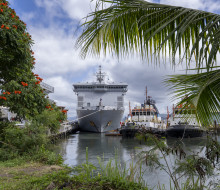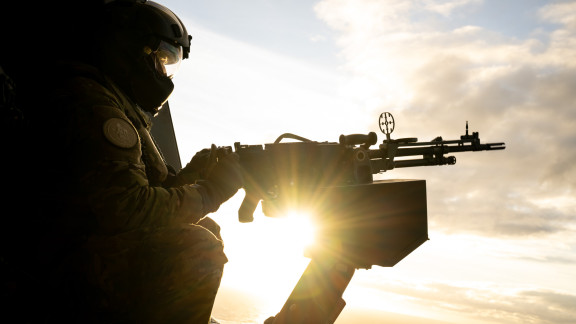
HMNZS Canterbury concludes week-long Fiji deployment
25 July 2025
Unfortunately you are viewing this website on an outdated browser which does not support the necessary features for us to provide an adequate experience. Please switch to a modern browser such as latest version of Google Chrome, Mozilla Firefox, Apple Safari or Microsoft Edge.
Ngā mihi nui
In the build-up to the high-tempo international warfighting Exercise Talisman Sabre in Australia next month the Royal New Zealand Air Force’s (RNZAF) NH90 helicopters and crews have been working on live-firing and formation flight skills.
Priorities for No. 3 Squadron were to ensure its crews were qualified on gunnery skills and experienced with low-level formation flying.
“We went back to basics working on flying larger formations in the low-level environment than we do day-to-day, ending with adding tactical overlays,” NH90 pilot Flight Lieutenant Rob Kenyon said.
It was a busy week, which was reflective of how it would look during Talisman Sabre and the training worked well, he said.
The gunnery training took place at night as well as during the day, to highlight the different challenges of shooting without daylight.
“At night there’s obviously restricted vision and crew members needed to use night vision goggles. It’s also been two years since we’ve done that gunnery qualification training, so it was challenging and beneficial for the planners from that perspective.”
Talisman Sabre was designed as a conflict scenario exercise, so it was imperative to build up those skills, FLTLT Kenyon said.
“We need to be a combat-capable unit for if the government ever calls on us to work in that warfighting environment. The big thing with Talisman Sabre is the multi-national force integration. When we get to Australia, the work will be the same, but on a much bigger scale.”
For helicopter loadmaster Corporal Sam Swift the training was a chance for her to gain currency in the weapons and formation flying skills.
“We did day and night practise, firing from a hover, firing from a departing hover, doing a fly past while firing and firing while approaching a hover. Now we’re qualified on the MAG 58 machine gun.”
The training took place at the weapons range at Raumai, north of RNZAF Base Ohakea.

Live-fire from an NH90 helicopter | Royal New Zealand Air Force
“It's great for contributing to our operational effectiveness as a squadron because battlefield support is one of our outputs.”
CPL Swift also took part in the three-ship formation flying training in preparation for the multi-national helicopter formations that will take place in Australia.
“Doing a formation of more than two aircraft is really beneficial for us to build in those skills of working together in a formation and having that awareness of other aircraft around us. It builds in that complexity of how we manoeuvre in the space.”
No. 3 Squadron crews will be working alongside the Royal Australian Air Force’s Chinook fleet, she said.
“I'm really excited. This will be my first big international exercise and it'll be my first time going on Talisman Sabre. Battlefield operations and battlefield support is what I really wanted to do and what I enjoy the most in our job,” CPL Swift said.
In total, more than 680 New Zealand Defence Force personnel will deploy on the exercise and work alongside more than 30,000 military personnel and platforms from 19 nations.
Included in the RNZAF’s contribution to the exercise will be three NH90 helicopters a P-8A Poseidon and a number of supporting ground and air units.
Talisman Sabre will incorporate joint training scenarios including amphibious landings, maritime identification and interception, air operations, live-fire exercises, and logistics support across a vast training area, including in Australia’s Northern Territory and Queensland, and in the Coral Sea.
Priorities for No. 3 Squadron were to ensure its crews were qualified on gunnery skills and experienced with low-level formation flying.
Priorities for No. 3 Squadron were to ensure its crews were qualified on gunnery skills and experienced with low-level formation flying.
Priorities for No. 3 Squadron were to ensure its crews were qualified on gunnery skills and experienced with low-level formation flying.
Priorities for No. 3 Squadron were to ensure its crews were qualified on gunnery skills and experienced with low-level formation flying.
Priorities for No. 3 Squadron were to ensure its crews were qualified on gunnery skills and experienced with low-level formation flying.